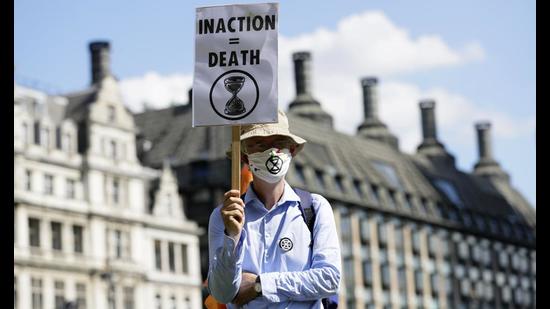COP26: Play both the good and bad cop
India is a climate leader that delivers and can ramp up its ambitions. But it must also point to the utter hypocrisy of the developed world
As the planet warms, the politics heats up faster. Some have labelled the imminent COP-26 climate negotiations talks as the “last chance” to stabilise global temperature rise. But expectations from COP-26 depend on who you ask. Cut through the clutter and one finds two competing narratives.

One says that the only way to save the planet is to raise long-term climate ambition. The second says the only way to save the planet is to deliver on existing commitments and providing resources to do so. For successful negotiations, these positions must be bridged.
The carbon equation points to a very limited carbon budget. Applied to the planet as a whole, it does not say why the budget is limited nor introduces equity into who gets what share.
There is also a trust equation. Credibility and reliability of commitments are coloured by past actions and inactions. Trust is inversely proportional to self-orientation. The more developed countries focus only on self-interest, the less developing countries will trust promises for the future.
If India played good cop, what should it say? India is a climate leader that delivers. With 38.5% of non-fossil fuel electricity generation capacity already installed, India is well on track to reaching the 40% target it declared in its Nationally Determined Contribution. Against its emission intensity of GDP pledge of 33-35% reduction by 2030 against 2005 levels, it has already reduced by 24%.
India can raise the game. It tabled the target of 450 GW of renewables by 2030 via an Energy Compact submitted to the United Nations High-Level Dialogue on Energy last month, signalling a double leapfrog: connecting nearly all households to electricity while shifting rapidly to clean power. The new National Hydrogen Energy Mission, with focus on lowering costs of green hydrogen, can significantly support decarbonisation of heavy industry and long-distance transport.
Indian industry can showcase its plans. National Thermal Power Corporation Ltd., alone, plans to install more than 50 GW of renewables by 2030. ITC Ltd. wants 50% share of renewable energy in its energy mix by 2030. Cement companies, such as JK, JSW and Ultratech, are pursuing clean energy share of 30-75% within the decade.
India can consider setting a net-zero target year (not before 2070) bolstered by short-term sectoral pathways — making these commitments contingent on technological advances and capital availability. Its actions will still be more progressive compared to the largest emitters since India’s cumulative emissions (1900-2100) would be lower than China’s, the United States’ or the European Union’s.
As a highly climate-vulnerable country, India must build resilience against climate shocks. It has created the Coalition for Disaster Resilient Infrastructure. It should focus on deepening local administrative capacity to not only save lives but protect livelihoods from increasing climate risks.
Playing nice is not enough. As bad cop, India should point out the hypocrisy in how the climate narrative is being shaped. Since 2008, rich countries emitted nine years’ worth of India’s emissions over and above what they had committed to. Yet, the narrative has magically shifted to evaluating what countries are promising for the future rather than what they delivered in the past. Every year of inaction from developed countries took away carbon space from developing ones. Such greenwash is unjust and inequitable.
The direction COP-26 takes will hinge on getting the basics right. Here is my wishlist for how COP-26 could be good for the planet and just for majority of the world’s people.
One, a clearly stated aspiration from developed countries that they will aim to reach net-zero emissions well before 2050 and strive for net-negative emissions by 2050.
Two, a pathway to $100 billion “as a floor, not a ceiling” with a ratcheting mechanism to raise public finance contributions.
Three, a deal on financial de-risking, to attract at least $1 trillion of private institutional capital into clean energy infrastructure in developing countries by 2030.
Four, a compensation fund to clear the backlog of 3.91 billion unissued or unsold Certified Emission Reduction credits under the Clean Development Mechanism. This would resolve a negotiation logjam and enable a market mechanism under Article 6.4 of the Paris Agreement.
Five, a Global Resilience Reserve Fund, capitalised by an allocation of the IMF’s Special Drawing Rights, to create an insurance safety net against climate shocks.
Six, technology platforms to co-develop critical climate-friendly technologies (greenhouse gas removal; a Global Green Hydrogen Alliance), with pooled resources and joint ownership of intellectual property.
Seven, a multilateral and multi-stakeholder platform to drive large-scale adoption of productive uses of clean energy and stimulate jobs and growth in rural economies globally — bringing the energy transition closer to people.
Rather than wordsmithing language only negotiators understand, their political masters must send a different memo: Invest in the building blocks of collective action, namely ambition, action, financial contributions, technology collaborations, insurance cushions, and development orientation. If the trust equation is undermined, there is little hope that the integrity of the carbon equation will be maintained.
Arunabha Ghosh is CEO, Council on Energy, Environment and Water
The views expressed are personal
All Access.
One Subscription.
Get 360° coverage—from daily headlines
to 100 year archives.



HT App & Website







